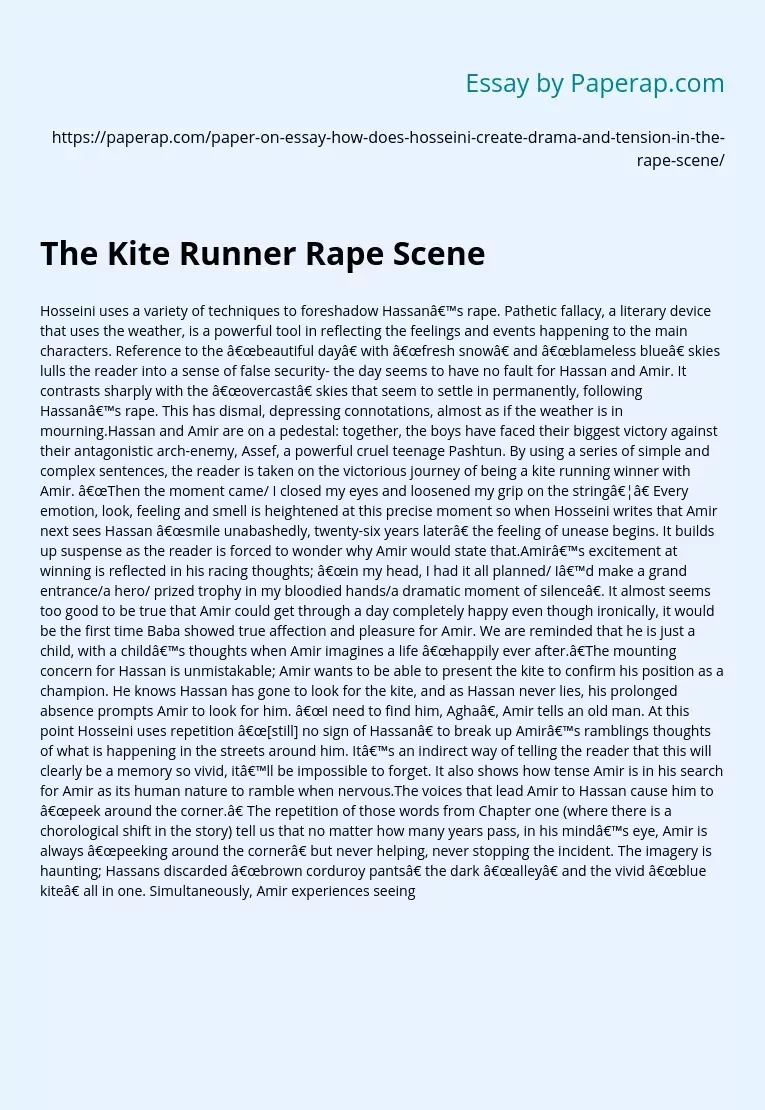The Kite Runner Rape Scene
Hosseini uses a variety of techniques to foreshadow Hassan’s rape. Pathetic fallacy, a literary device that uses the weather, is a powerful tool in reflecting the feelings and events happening to the main characters. Reference to the “beautiful day” with “fresh snow” and “blameless blue” skies lulls the reader into a sense of false security- the day seems to have no fault for Hassan and Amir. It contrasts sharply with the “overcast” skies that seem to settle in permanently, following Hassan’s rape.
This has dismal, depressing connotations, almost as if the weather is in mourning.Hassan and Amir are on a pedestal: together, the boys have faced their biggest victory against their antagonistic arch-enemy, Assef, a powerful cruel teenage Pashtun. By using a series of simple and complex sentences, the reader is taken on the victorious journey of being a kite running winner with Amir. “Then the moment came/ I closed my eyes and loosened my grip on the string…” Every emotion, look, feeling and smell is heightened at this precise moment so when Hosseini writes that Amir next sees Hassan “smile unabashedly, twenty-six years later” the feeling of unease begins.
It builds up suspense as the reader is forced to wonder why Amir would state that.Amir’s excitement at winning is reflected in his racing thoughts; “in my head, I had it all planned/ I’d make a grand entrance/a hero/ prized trophy in my bloodied hands/a dramatic moment of silence”. It almost seems too good to be true that Amir could get through a day completely happy even though ironically, it would be the first time Baba showed true affection and pleasure for Amir.
We are reminded that he is just a child, with a child’s thoughts when Amir imagines a life “happily ever after.”The mounting concern for Hassan is unmistakable; Amir wants to be able to present the kite to confirm his position as a champion. He knows Hassan has gone to look for the kite, and as Hassan never lies, his prolonged absence prompts Amir to look for him. “I need to find him, Agha”, Amir tells an old man. At this point Hosseini uses repetition “[still] no sign of Hassan” to break up Amir’s ramblings thoughts of what is happening in the streets around him. It’s an indirect way of telling the reader that this will clearly be a memory so vivid, it’ll be impossible to forget. It also shows how tense Amir is in his search for Amir as its human nature to ramble when nervous.The voices that lead Amir to Hassan cause him to “peek around the corner.” The repetition of those words from Chapter one (where there is a chorological shift in the story) tell us that no matter how many years pass, in his mind’s eye, Amir is always “peeking around the corner” but never helping, never stopping the incident. The imagery is haunting; Hassans discarded “brown corduroy pants” the dark “alley” and the vivid “blue kite” all in one. Simultaneously, Amir experiences seeing his greatest victory and greatest regret in one which highlights the books major themes of unatoned sins, failures and successes. The climax of the scene is written in short, simple sentences, “Hassan didn’t struggle/didn’t whimper/looked resigned/ the look of a lamb” to create a sense of finality, the emotional shift from childhood and innocence to remorse and corruption.Earlier in the novel, Amir, in his first person narrative voice, tells the reader that he and Hassan have grown up experiencing everything together; and the irony in this is that they both experience their first real tragedy together too .
The Kite Runner Rape Scene. (2019, Dec 05). Retrieved from https://paperap.com/paper-on-essay-how-does-hosseini-create-drama-and-tension-in-the-rape-scene/

